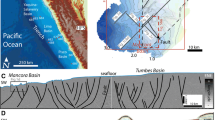Abstract
Destabilization of gas hydrates from the North Atlantic polar continental margins is geophysically detectable within hydrate stability zones (HSZ). High-frequency seismic surveys of structures and propagation velocities of compressional waves have changed the classic conception of a consistently stable hydrate zone. The results are important in two respects: (1) unstable shallow-water gas hydrates can substantially contribute to the transfer of methane into the atmosphere, and (2) deep-water gas hydrates also indicate destabilization, which results in slope instability with probably only a secondary role in the transfer of methane to the atmosphere and thus in the greenhouse effect.
Similar content being viewed by others
Author information
Authors and Affiliations
Additional information
Received: 6 August 1997 / Revision received: 26 January 1998
Rights and permissions
About this article
Cite this article
Mienert, J., Posewang, J. Evidence of shallow- and deep-water gas hydrate destabilizations in North Atlantic polar continental margin sediments. Geo-Marine Letters 19, 143–149 (1999). https://doi.org/10.1007/s003670050101
Issue Date:
DOI: https://doi.org/10.1007/s003670050101



